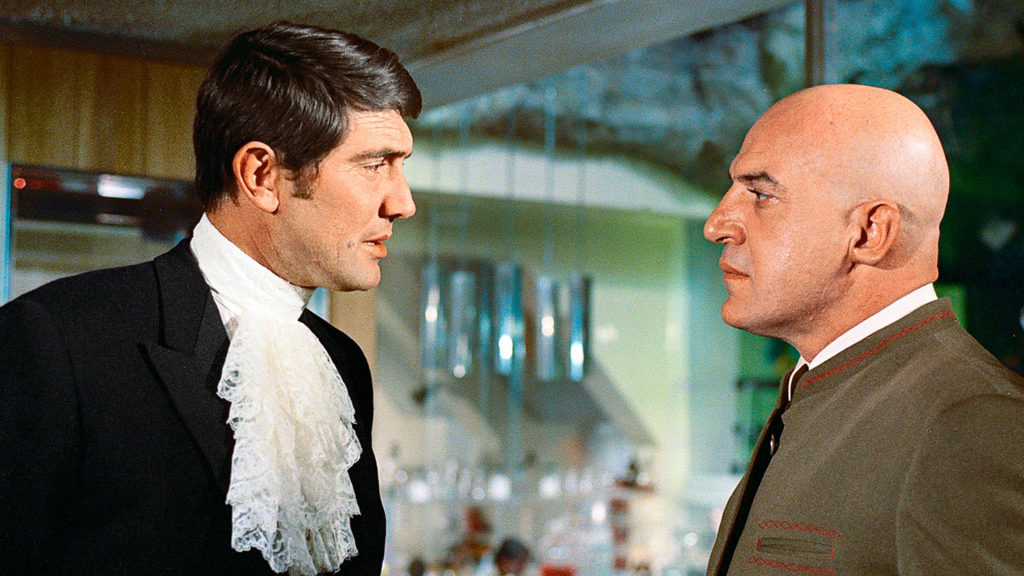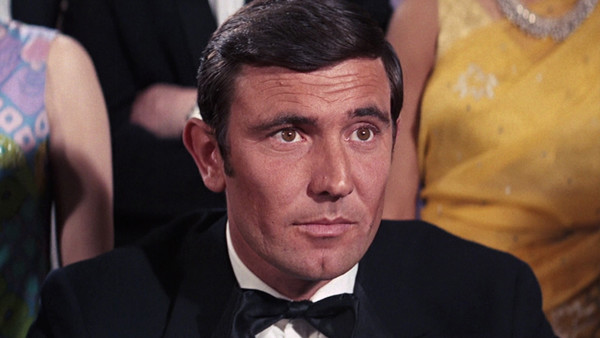“We’ll be going on soon. There’s no hurry, you see. We have all the time in the world.”
On Her Majesty’s Secret Service, which came two years after the release of the previous 007 film, You Only Live Twice, is a bit of an oddity. It was the first in the series to have a new actor in the role of Ian Fleming’s James Bond. Carrying 007’s Walther PPK and driving the Aston Martin DBS is former car salesman, and male-model Australian, George Lazenby.
So no matter how many people get fired up about casting the next Bond, lets remember that the producers didn’t sound like they were too interested in someone capable of exceptional acting. That being said, Lazenby does all right. And the script by Richard Maibaum is fairly faithful to the original source material, the eleventh in the series (including a collection of short stories). Which is something they wanted to return to after some more of the fantastical elements that had been cropping up in the series. Especially in the previous release, You Only Live Twice.
In fact, I have fervently believed that had Sean Connery remained in the role, this could have been his best performance. It lets Bond do something he hasn’t done in previous films. Grow as a character, and in fact, falls in love. In Connery’s hands this could have been really exceptional, and would have opened up the character in interesting ways. Lazenby does passably well.
That being said, producers Albert ‘Cubby’ Broccoli and Harry Saltzman had some problems with the young actor. He was twenty-nine at the time. He was brash and cocky, taking risks off the set, skiing. Breaking an arm, as well as insisting on doing as many of his own stunts as he was able. And even as the production carried on, he voiced his conviction that he would not return to play the character again, feeling the films’ era was over.
The tabloids didn’t help either by trying to stir up trouble on the set. And drawing (inevitable) comparisons between himself and Connery.
The story is epic, and expansive in scope. The film comes in with a fairly lengthy runtime, almost two and a half hours. Shot on location in Switzerland, Portugal. And with some sets and interiors at Pinewood Studios in England the film launches Bond into an all new adventure that sees him going up against Blofeld and SPECRE (again). This time, Blofeld is played by Telly Savalas, an interesting choice. But he does bring a bit of a quiet menace to the role.
Blofeld has a plan tying in allergy research, and a virus that could threaten everything. So Bond goes undercover (and since they are both different actors the characters don’t recognise one another despite being face to face in the previous film) at his mountain top base, at Piz Gloria in Switzerland. Cue ski and luge chases, the first time either are seen in a Bond film.
But the emotional heart of the movie, and this Bond film has one. Is that James Bond actually does fall in love. With Tracey (Diana Rigg). Her father, Draco (Gabriele Ferzetti) is connected in the criminal underworld and he agrees to supply Bond with Blofeld’s location if the agent will romance his daughter, whom he believes likes James. He’s right, and despite the trope, Bond likes her too.
In fact, it progresses so far that James is ready to retire from the service (something he actually attempts to do near the beginning of the film) and marry Tracey. Which of course leads to the emotional punch and downer of an ending – spoiler, I guess. I mean the film has been around since 1969. Still, it is a poignant moment.
It’s made more so by John Barry’s fantastic score. He’s right on his game here. And the film eschews a vocal theme to deliver us an opening title sequence with a fantastically bombastic theme. While Maurice Binder delivers us an iconic title sequence which gives us glimpses at previous adventures. Reminding us that despite the change of face, this is still the same Bond. Something that is echoed when James is clearing out his desk. His only glimpse to date in the series of his office. We hear the themes from different films as he goes through the memories in his desk.
Barry’s driven score amps up the action beautifully, and there are some nice action sequences in the film. But like the story, the music of the film has a nice emotional core. As well with Louis Armstrong crooning out We Have All the Time in the World. Which serves as the film’s love theme – something else Bond films tend not to have. It was also the last song Armstrong recorded before his death two years later.
Behind the scenes, familiar faces abound. Peter Hunt, who had served as Editor or Editorial Supervisor on the previous 007 films had the big seat pulled out for him, and directed this one. While John Glen (remember I told you to watch out for that name?) takes over as Editor, while also serving as a Second Unit Director .
John Stears, who would later work on Star Wars, returns to oversee Special Effects, something he’s done on the deries since From Russia With Love. While George Leech, who’d been involved with all the films in the series except, From Russia, returns as Stunt Coordinator.
Syd Cain who had previously served as Art Director for the series moves up to Production Designer. The opulent sets of Ken Adam are absent from this entry, though not necessarily missed. Cain brings an attention to detail that layers in a more grounded reality to the series, designing coats of arms. Meanwhile, another name to watch is Peter Lamot who works on Set Decoration in this film. And like Cain, Adam become inextricably entwined with the look and feel of the Bond franchise.
Joining Lazenby on screen again is Bernard Lee as M, Lois Maxwell as Moneypenny, and Desmond Llewelyn as Q. Though the armourer doesn’t have much to do in this film. As it is Bond who has all the gadgets this time around, as he confides to the equipment officer.
The film also reveals Bond’s own coat of arms with the legend ‘Orbis non sufficit,’ which would serve as the title of a later Bond film in its English form, The World Is Not Enough.
Prior to the film’s international release, with staggered dates throughout December of 1969, the art department went to work on creating the posters that would herald the arrival of the new Bond. A ridiculous looking poster with Bond’s face blocked out with text surrounded by women made the rounds in the U.S. before the artwork of Frank McCarthy and Robert McGinnis delivered yet another iconic poster with the tag lines Far Up! Far Out! Far More! which highlighted the action, and the sense of suave cool that was symbolic of the series at the time. Though once again the Japanese hand tinted photo montage one sheet is cool. And the French door panel poster is pretty cool as well.
The film performed very well, showing that the series could survive a change in actor. Which I’m sure no doubt delighted the producers. It fell just short of the earnings of a Connery Bond. But showed that if the production could find the right actor, story, locations, and all the ingredients one expected in a Bond film, it could be a rousing success.
That being said, On Her Majesty’s Secret Service remains a satisfying oddity. As Lazenby only suited up once, and then more or less vanished from cinema for the longest time after that. It is also unique in the opening, emotionally of the Bond character, something we wouldn’t see for another decade or two when another actor with a limited James Bond run layered in some more emotion in his performance.
But could you imagine if this had been Connery, and the script stayed close to the same as it was…. This would have been his best. I’m sure of it. And it would have given Connery the chance to emote a little more, and develop the character, as opposed to being the indestructible superhero he was on his way to becoming in the previous films.
As always as the film drew to a close, we were delivered a promise by the film’s producers. James Bond will return in… Diamonds Are Forever.
Thanks once again to DK Canada for allowing me use of their in depth 007 library in the form of the amazing Bond By Design: The Art of the James Bond Films, James Bond: 50 Years of Movie Posters, and The James Bond Encyclopedia.
- Release Date: 12/18/1969





